
| Volume 20, Issue 1 | January 21, 2018 |
 |
|
In this Issue:
|

| Volume 20, Issue 1 | January 21, 2018 |
 |
|
In this Issue:
|
If we can talk with one another in a civil way, chances are good we shall find there is much more with which we can agree than disagree. Science tells us that regardless of culture, country, or race, all peoples around the world have in common 99.5% of human DNA. Yes, we can emphasize the differences and revel in what makes us unique, but if in doing so we lose sight of the much greater ways in which we are alike, there is a danger of also giving up our capacity for cooperation, compassion, and constructive compromise, without which there may be lots of self-congratulatory moments of finger-pointing and blaming one another for this or that, yet the vital work of resolving real issues and supporting the causes of all participants in a political dialogue will be left undone, sometimes for several decades. As this trend toward discord and division becomes widespread in the West, China and Russia will be the short-term beneficiaries, but the long-term future of generations could be in greater jeopardy.
Let us not, then, seek idealistic "kumbaya" love-fest moments of camaraderie with those whose assertions push our buttons, but instead simple, genuine acknowledgement of others' having legitimate points of view, deserving of our deference, while accepting too that out of disparities can arise functional solutions of benefit to all parties.
There have been many fine statesmen in American history, men and women of multiple and strongly held outlooks, who nonetheless rolled up their legislative or executive branch sleeves and did what was called for to promote and pass laws in the interest of all. In the long view, both major parties have helped construct a country that is in many ways the envy of the world, yet neither has acquitted itself with grand moral distinction relative to the other.
Our partisan disputes may make for good political theater yet are far worse than a mere waste of time, serenity, and vast sums of money. The greatness of our nation, I would argue, is built upon its diversity, its genius for finding and enhancing mutual, core values, its practical furtherance of the common good while respecting at once the rights of those currently in the minority and the majority.
A brother of mine, a manager at IRS, needed skills at having employees cooperate to solve human resource and productivity problems within the context of his organization's mission. Lately the focus in social media, politicians' rhetoric, or entertainment news programs (that tell us how great we are and how awful are those who have alternative opinions) all seem to be urging us to answer "No," and then crow about it. By contrast, my brother suggested as a great resource the book by Roger Risher and William Ury, Getting to Yes - Negotiating Agreement Without Giving In. While this is not easy, it is evidently worthwhile compared with most alternatives.
I admire the commentaries of Mark Shields and David Brooks. These two journalists, more than usually mellow, while having views more consistent with the Democrats and the Republicans, respectively, manage week after week to express their often opposing viewpoints with civility, humor, and depth of perspective. At times I am more persuaded by one, at times by the other. Together, their approach would seem to add a useful measure of sanity to the present, crazy-seeming cacophony.
Similarly, I am encouraged there are now organizations like Better Angels (better-angels.org), Bipartisan Policy Center (bipartisanpolicy.org), and NoLabels (nolabels.org). These non-profit groups seek real dialogue and solutions, ones that combine the best from our political professionals of diverse backgrounds and parties. They and others like them can help us replace division with understanding. Out of that may come progress. We certainly must have it, and about time!
Perhaps we like to think the Biblical injunction to "Love your enemies" does not really apply in politics, but might we at least deal with them with respect?
It is as if two people on an island were hungry, each now with one dysfunctional arm and blaming the other for it, yet otherwise healthy and provided with a supply of seed. They could both die of starvation or somehow manage to work together to put in and take care of a garden that could feed them both well.
We can also think of the situation in terms of carrots and sticks. A powerful stick, in my view: if America does not quickly get its national act in order, it will be badly weakened, its influence on the world stage reduced, a vacuum that our main anti-democratic global competitors, China and Russia, will be delighted to fill, to our detriment and that of our closest allies.
Yet if we can more and more overcome our differences and emphasize what unites us, rather nutritious and tasty carrots might be in our future: stabilizing entitlements; reducing the national debt; adding tens of millions in new jobs; establishing a health care system that is cost-effective and works better for most everyone; enhancing the kinds of research and development that have made many of our universities great and kept us in the forefront, for instance, of technological and medical innovation; maintaining a strong national defense; increasing trade and international ties; fixing our aging infrastructure; dealing with greater weather instability; and reducing the gulf between our richest and poorest citizens.
As we approach a new Valentine season, gold stars ought to go not to those who can score the most points against people with whom they disagree, but to the folks seeking, despite an abundance of self-serving propaganda, spin, lies, fake news, or prejudicial exaggerations, the means to simply reach agreement with which we can live. Do we cherish and admire our political opponents? In most cases probably not, at least not about their biased positions.
Yet if it were clear to us that the quality of the lives of our nieces, grandnieces, nephews, grandnephews, children, and grandchildren depended on it, could we find ways to actually get key matters accomplished, notwithstanding a measure of underlying distrust, even enmity, in the process? Most likely.
In fact, that may well be what is at stake. So let us get on with it!
It is fun to discover a new place. Traveling around the country, or even world, to see areas for the first time is quite appealing, and many people embrace their urge to explore new horizons, driving or flying to widespread destinations during their vacation time, which can be a precious resource during one's working career. While I like to do the same, I have come to realize that I don't share that same level of enthusiasm for the initial visit. Getting to know a place through multiple experiences seems more my style. In fact, many places that I find unappealing at first turn out to be more hospitable with time and familiarity. My current domicile is a case in point. When I moved to Austin, TX, over three decades ago, my initial
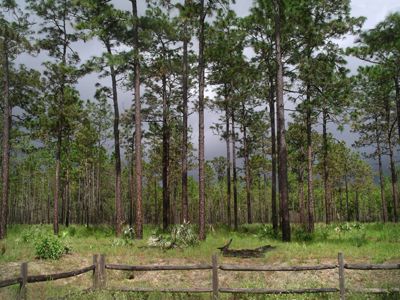 The Sandhill Trail in Silver Springs State Park, Florida. |
Of course, I'm still here, and I've not only become accustomed to the climate, but have discovered activities and aspects of the place that make life here downright good. I don't feel like leaving. But I DO like to visit some other favorite haunts now and then.
One such place is Ocala, FL, where my mother lives. I've occasionally traveled in the Sunshine State throughout my whole life, and even lived in Tallahassee for a couple of years. I'm familiar with the area and have sites that I specifically like to return to just about every time I can. Seeing the same spot in different seasons and conditions, even if my visits are spread over years, brings a comfortable sense of belonging, while allowing me to add layers of observations and understanding to the ecosystem in which I'm wandering.
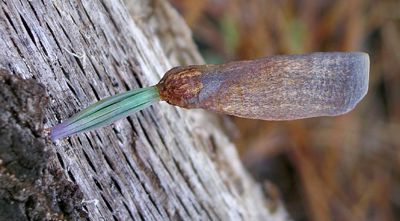 A longleaf pine seedling with its seed cover still attached. |
A very specific locale that offers constant entertainment for a nature nerd like me is the Sandhill Trail within Silver Springs State Park. All I have to do is walk around the parking lot and I never fail to see something that catches my attention. I can spend hours poking around just within sight of the ranger station at the entrance to the park.
Why is this one little area so intriguing? It is simply a fairly open pine woods, with a bunch of native vegetation in very sandy soil. There is no water source immediately adjacent, although the river and swampy areas are not terribly far away. The vegetation is exceptionally diverse, and the explanation is apparent: controlled burns are conducted about every five years or so.
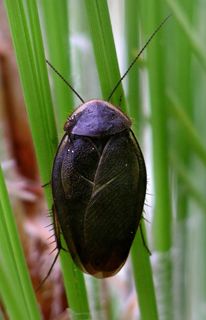 A Florida Sand Roach with exceptionally dark coloration. |
The sand pine habitat of Florida is shaped by a basic fact of the local climate; nowhere else in the U.S. are there so many lightning strikes. Frequent lightning causes fires and, over millennia, the vegetation has adapted to thrive under these circumstances. The longleaf pine seeds need the fire to clear ground cover and prepare the soil for their optimum germination. Because lightning usually accompanies rain storms, the ashy soil left in between dead or fallen trees after a blaze will often retain the moisture that seedlings require.
The widely spaced pines provide an almost park-like environment at ground level. After a fire, most of the low foliage is gone, but many of those plants have deep roots and regenerate quickly. Others are annuals with thickly covered seeds that sprout rapidly in the now ideal conditions. Just weeks after a burn, new growth is everywhere. The most inconvenient aspect of walking through a recently devastated plot is that the charcoal branches and logs leave their soot on pant legs, shoes, arms and anything else that touches them. It's a mess to clean off, and it takes many months of rains to finally wash away that soft black layer.
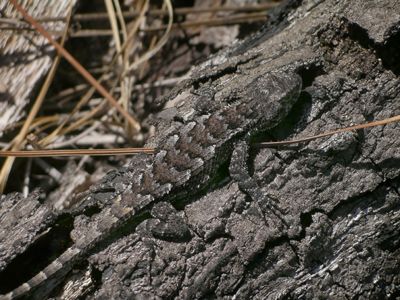 A dark-hued Fence Lizard warms itself on a fallen burnt log. |
It might seem counterintuitive to choose to stroll through a wooded area recurrently denuded by fire. And, in fact, I wasn't immediately enamored with that type of habitat. For someone interested in nature, wildlife, ecology, or botany, though, it is a fascinating and singular sort of site. Diversity is the spice of life, and life in all its varieties can be a source of endless wonder.
| The attractive studio wedding picture shown here was taken in the Joliet, IL, area around 1925 or so. The couple are Helen (1907-1999) and Jack (1901-1969), aunt and uncle of Evelyn, Val's mom. Jack (whose real name was John) had five brothers, one of whom was Evelyn's father, Charles. Jack and another brother, Joe, ran a very successful insurance business in Joliet. Jack and his wife lived in the Forest Park area in NE Joliet and had three children. Helen's family had a genetic peculiarity in which one leg was shorter than the other. She displayed this trait as did one of her sons. Jack was popular and active in the Forest Park community and was known fondly as the "Mayor of the Hill." |

|
![]()
| (The Terra Tabloid is a venue for the discussion of issues pertaining to the past, present, and future of our planet and human interaction with it.) |
Calling themselves "Swamp Apes," a collection of mostly U.S. military vets in FL are combating stress bagging Burmese pythons, over 500 of them so far. Veterans often have trouble adjusting after foreign engagements. The python eradication program offers a combination of adrenaline rush, a sense of mission, group cohesion, and danger similar to typical war zone experiences overseas, aiding in soldiers' transitions back to civilian life. Swamp Apes was founded by Thomas Rahill, not a veteran himself, who has taken on a dual task, to aid the FL ecology by removing the pythons from the Everglades and similar, nearby environments while also giving veteran volunteers a chance for therapy. Performing useful service in this way helps them channel and work through the energy, stress, or grief leftover from combat commitments.
Known for its previously dominant native alligator species, the vast Everglades is being taken over by large numbers of the pythons, thought to have been introduced into FL wetlands around the 1980s, when pet owners grew tired of keeping the reptiles themselves. The problem was significantly worsened in 1992 when Hurricane Andrew destroyed a breeding facility, releasing many young Burmese pythons into the national park. The area ecology has proven ideal for this destructive species, so much so that alligators are declining there even as the constrictor snakes are spreading to surrounding territories. Burmese pythons can reach 23 feet in length, eat more or less everything the alligators do plus the alligators themselves, can also reproduce faster than the local Crocodilians, and are devastating the one-of-a-kind watery settings in southwest FL. An estimated 100,000 of the pythons are alive in FL today. The rise in their numbers coincides not only with a decline in alligators but a 99% loss of area raccoon and opossum numbers plus an 88% decrease in bobcats.
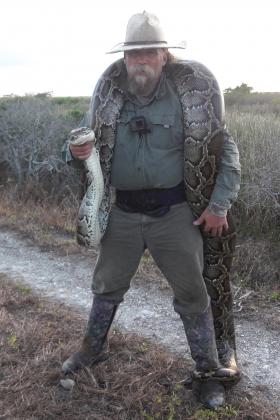 Thomas Rahill with Burmese Python (NPR.org) |
FL officials have been trying multiple means to control the large snakes, including employing machete wielding snake hunter tribesmen from India. Now the Swamp Apes are taking their turn at the cause. These veterans do not go after only the Burmese pythons but help control a variety of invasive plants and animals in FL. Still, with several hundred bagged and mostly euthanized Burmese pythons under their collective belt, the Swamp Apes are making a needed contribution to this particular effort at managing unwanted species.
Work in the challenging Everglades environment distracts Swamp Apes from dark obsessions. Thomas Rahill says combat vets have nightmares or flashbacks from wartime. Yet in the small groups of five or so volunteers that he leads into the Everglades each week for shifts lasting six, seven, even twelve hours, the snake hunters work through and often go beyond their PTSD symptoms.
Rahill also was dealing with deep emotions when he took on this preservation work. Out of financial necessity, his wife took a distant job in 2008. Their being apart was highly upsetting for him. A telecommunications administrator, he added volunteer hours, making trails and snake hunting, and found these activities took his mind off his negativity. Two relatives who were veterans gave him the idea to employ vets in such work. It gave him an added sense of purpose to combine the ecological support mission with assisting others in coping with the skeletons in their closets. The endeavor has been successful for Rahill, his vet volunteers, and the FL ecology.
The Swamp Apes have cooperated with the University of South FL in researching the joint benefits of their wilderness enhancing and PTSD therapy program, the findings due to be presented to the American Public Health Association. They hope their model can be exported to other venues and parts of the U.S. having similar conjunctions of dangerous environmental threats with folks wanting to exorcise their collective demons.
Indeed, looking at FL alone, much more could be done, both in terms of the need for help with PTSD and the challenges of species harmful to native ecology. It is clear that, for all the good they have done so far, the Swamp Ape's removal of about 500 Burmese pythons from the Everglades is but 0.5% of the need. And there are still in that state aggressive troupes of rhesus macaques (that have taken over areas of one of its more popular parks) plus 500,000 feral hogs yet to be dealt with. Nationwide, the latter are said to number in the millions, doing billions in environmental and agricultural damage. Nor are difficulties related to PTSD going away soon.
Primary sources:
Python Patrol: Group of Mostly Military Veterans Hunts Snakes to Help Combat Stress. Ken Kaye in www.sun-sentinel.com; June 15, 2015;
Florida Veterans Fight a New Enemy: Invasive Snakes in the Everglades. in wunc.org [North Carolina Public Radio]; November 13, 2017.
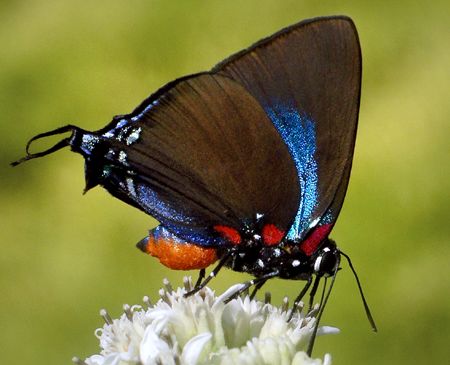
The great purple hairstreak (Atlides halesus) is one of our most distinctive butterflies, with its classy black wings and outrageously colorful highlights. The most beautiful view of the wings is seen only in flight; the insect always perches with its wings closed above its body, hiding the iridescent blue of the upper sides. The common name is a conundrum as the butterfly has orange, red, blue and turquoise colors, but no purple. The bright hues, contrasting with black and white, are aposematic, meaning they are meant to deter predators by warning them of distasteful poison. The adult hairstreak acquires its toxic protection as a caterpillar which feeds exclusively on mistletoe, a plant with chemical defenses so intense that only a small number of insect species are capable of eating it.
Great purple hairstreaks usually occur in low numbers throughout the warm months. They often spend a lot of time walking inconspicuously on clusters of flowers as they sip nectar instead of fluttering a lot. The individual shown above is a male; females lack the blue coloration on the underside of the forewing.
With the stock market making new record highs every day or so and already by several measures overvalued, knowledgeable investors might be frustrated that there are not many great opportunities available. Yet, it is seldom advisable to be completely out of stocks unless one's investing time horizon is fairly limited. There is no telling just when a market's sellers will outnumber buyers and so precipitate a major downturn. This bull market could continue for a few weeks, months, or even years. Meanwhile, a long-term investor might at least focus on relatively safe equities. Over the decades, what matters most to investors is probably how much income his or her portfolio offers, both that provided by capital appreciation and by their stocks' total yield. The latter can be secured in both up and down markets, so long as the companies in which we invest are unlikely to fail or cut their dividends.
It seems reasonable, then, even at fairly lofty market levels, to put a portion of one's assets into sound companies with a bit above average yield, then invest enough each year to guarantee growth of that income stream. For example, if one began with income from stocks of, say, $1000 a year, this could be increased through new investing or the companies raising their dividends, which tends to occur rather regularly among profitable corporations. Should this growth in income be at a rate of, for instance, 13% a year, that initial $1000 in annual dividends would become almost $40,000 ($39,150) after 30 years, i.e. a compounded doubling of one's income roughly every 5.65 years. Such income gains would be independent of the rise or fall of the total market price of one's portfolio, in that sense a risk-free standard by which to assess one's progress as an investor.
With the stock market's annual dividends now averaging only about 1.90%, I have looked for very low risk stocks that offer 2.0% or better yields as well as above average long-term total return prospects, excellent financial strength, and recommendations for their purchase from one or more well respected investment services.
| Company | Ticker Symbol | Recent Price | Dividend Yield |
|---|---|---|---|
| CVS Health | CVS | $79.50 | 2.50% |
| Franklin Resources | BEN | $44.90 | 2.10% |
| Infosys, Ltd. | INFY | $18.12 | 2.20% |
| Schlumberger | SLB | $77.21 | 2.60% |
| Walgreens Boots Alliance | WBA | $75.78 | 2.10% |
At the table, please find a selection of such stocks. On average, they are likely to double one's investment on a total return basis in the next 5-6 years, meanwhile providing average dividends of 2.30% annually, perhaps not a bad way to wait out the "irrational exuberance" that might be playing out at this time. Once the inevitable next market correction has created new bargains, one's portfolio can be enhanced with more lucrative prospects. Till then, one could do much worse than to double one's dividend income every five years or so while also seeing on average a rising portfolio. By contrast, reasonably safe bonds with decent income offer far lower total return potential than financially strong company common stocks.
| |||||||||
|
Observation is one of the most engaging activities that consume our human lives. From atoms imaged by electron microscopes to minute, close encounters with aspects of our immediate environment to reaches beyond our physical capabilities, our species can see objects within our universe as never before. The data that has been received from the New Horizons mission to Pluto is a case in point. Just by visiting NASA's website, everyone can enjoy a glimpse of the outermost planet in our solar system. Be amazed!
|
| For others who may have chanced upon this site, larvalbug bytes is a monthly family-and-investment newsletter, put out by an old codger and sweet thing, with sometimes a little help as well from our engaging pooch, Peri. We invite readers' comments by and would also be happy to readers when new issues are published. Articles and stories from back issues are available in our archives. |

|
Copyright © 2018 by LARVALBUG
"Dragonfly Nebula" and larvalbug web design by Valerie.
![]()